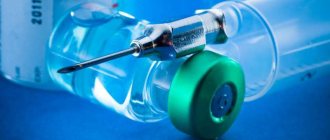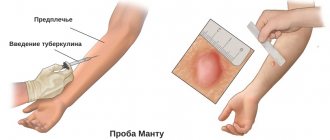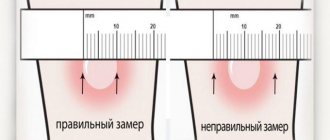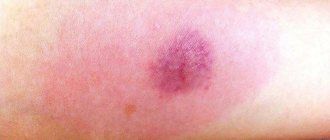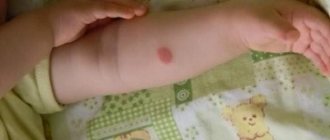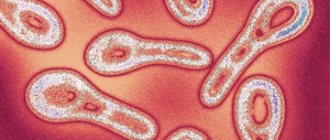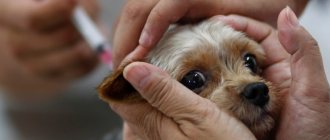Mantoux vaccination: normal size for a child, vaccination schedule, care rules
Wednesday, April 20, 2016
The main method of preventing tuberculosis, which is carried out from the first days of a little person’s life, is the Mantoux vaccination, which is done annually. This is a kind of test that determines the presence of tuberculosis infection in the lungs. Tuberculin is injected under the skin on the inside of the wrist, and then the doctor observes the body's reaction to it.
This is a drug artificially created from tuberculosis microbacteria. If a child experiences severe redness or swelling at the injection site after Mantoux, his body is already familiar with harmful bacteria. In this case, an additional examination is prescribed and the diagnosis is clarified. Parents should know basic information about why, how and when children are vaccinated with Mantoux in order to prevent their child from contracting tuberculosis.
Vaccination schedule
There is a general Mantoux vaccination schedule for children, which parents are usually informed about in advance. However, in some cases, additional tuberculin may be prescribed - more often than other children.
1. The very first Mantoux vaccination for a child, which is given to the baby upon birth, is given in the maternity hospital on days 3–7 of the little person’s life. Vaccination helps the body develop immunity against tuberculosis.
2. After this, as the Mantoux vaccination calendar for children says, tuberculin is administered annually for constant monitoring of Koch’s bacillus, which can become active at any time.
3. If the child’s tuberculin test increases every time or there are infected patients in the child’s environment, Mantoux vaccination is done more often - up to 2-3 times a year, depending on the results of tests and additional examinations.
Only a doctor (phthisiatrician) can determine how many times to vaccinate a child with Mantoux. This will depend on the body’s reaction to tuberculin, since there are certain standards that the doctor is guided by. They can be not only general, but also individual.
Dimensions
Not knowing what rate of Mantoux vaccination a child should have, parents are often perplexed: for some, the swelling is quite large, but they are not sent for a repeat test, and for others, it is smaller, but they are referred to a TB specialist. There are some nuances here that can reassure particularly worried parents.
1. The Mantoux test in a child is considered negative (i.e., there are no problems) if no lumps or redness are detected at the injection site.
2. A questionable reaction is observed with slight hyperemia (redness) and the presence of a papule (the so-called swelling that rises above the skin up to 5 mm). In this case, they take previous samples from previous years (they look at the dynamics), identify the presence of infected patients in the baby’s environment, and can send them for consultation to a phthisiatrician.
3. A positive test is the presence of a papule whose height exceeds 5 mm. Then a consultation with a specialist is required and in most cases a repeat test is performed.
4. A pronounced problem is the presence of a papule larger than 15 mm, the formation of a crust or vesicle at the injection site.
The peculiarity of this vaccine is that the size of the Mantoux vaccination in children looks at the dynamics of previous years, since the reaction in this case is very individual. If a child’s papule is always large in size, he may not be sent for repeated tests. But if the difference between the size of the swelling of two consecutive vaccinations is significant, this will certainly arouse suspicion among doctors, and the child will be sent for additional examinations. However, it is worth considering here that sometimes the cause of increased Mantoux in children is not infection with tuberculosis.
Three whole days pass between the injection of tuberculin under the child’s skin and the measurement of the reaction, and during this time certain rules must be followed. Without them, an increase in Mantoux can be provoked by various external and internal factors.
- Allergy : if present, any contact of the child with the allergen must be excluded. If it is unknown at the time of Mantoux vaccination, parents should protect the baby during these three days from treatment with any medications, consumption of sweets and red foods, as well as from contact with animals.
- Low-quality vaccine : Mantoux is given free of charge, so low-quality tuberculin can be delivered to any medical and child care facility, which will give a positive result in any situation. The error can be identified by contacting another institution (preferably a paid one) for re-vaccination after 3 days after the Mantoux measurement, which did not satisfy the parents. This will help you draw the right conclusions and not make a mistake with the diagnosis.
- Incorrect measurement : usually the Mantoux vaccination is done by a qualified doctor, but during measurements the human factor can play a cruel joke. The specialist checking the reaction could be inexperienced, could simply not take into account some individual characteristics of a small organism, could use the wrong ruler, and could, in the end, simply make a mistake due to fatigue.
- Individual characteristics : a positive Mantoux reaction can be observed due to a hereditary factor or the abundance of large amounts of protein foods in the child’s diet. So during three test days you need to reduce your baby’s consumption of eggs, meat, and dairy products.
To reduce all these factors to a minimum, there are certain rules for caring for the injection site after Mantoux vaccination. This allows you to make measurements on the third day more accurate and trouble-free. Unfortunately, doctors do not always give such information to parents, and the latter, in turn, are of little interest in this.
Rules of care
Useful tips in this case help to act competently during the 3 days allotted to the small organism for the Mantoux reaction.
1. These days it is not recommended to take a shower, bath or go to the sauna. However, depriving children of water procedures is also fundamentally wrong, since dirt that gets into the puncture site can provoke an even more dangerous infection.
2. Do not allow the child to rub the vaccination site, as this contributes to the appearance of compaction and redness.
3. Avoid contact with allergens: pets, citrus fruits, vegetables, red fruits and berries, synthetics and other dangerous items.
4. If redness and thickening still occur, give some antihistamines.
5. If your hand was wet in a body of water, report the incident to the doctor, who will do a Mantoux reaction reading.
6. Do not stick various plasters on the vaccination site, do not bandage your hand, do not smear it with any disinfectant solutions or ointments.
Since the incidence of tuberculosis is high, and the infection itself is quite serious, parents are advised not to give up the Mantoux test for children, which helps control the spread of the disease. At the same time, you need to understand that the tuberculosis vaccine does not protect the child from infection 100%. Infection may occur upon contact with a sick person. However, a vaccinated baby will get a milder form of the disease, which makes death unlikely.
Alternative to Mantoux
An alternative to the Mantoux test is another, relatively new, diagnostic method - “Diaskintest”. It, like the Mantoux test, is placed intradermally and the reaction is observed. Diaskintest is less allergenic and more accurate. But it shows the reaction specifically to the tuberculosis pathogen, and not the presence of antibodies. That is why a Mantoux test is done every year, and not a Diaskintest: to find out whether BCG “worked” and whether the child has protection against tuberculosis. If for some reason the child was not given BCG, then Diaskintest will indicate with more than 90% accuracy if the child is already infected. According to the general rules, in accordance with the procedure and timing of preventive medical examinations of citizens in order to detect tuberculosis, approved by Order of the Ministry of Health of the Russian Federation dated March 21, 2021 N 124n, every year from one year to 7 years inclusive, children are given a Mantoux test, and then up to 15 years old - Diaskintest.
Should I place manta rays per year? Let's summarize:
- At one year, the child is given a Mantoux test to find out whether he has antibodies to the tuberculosis pathogen after the BCG vaccination, which is given in the first days after birth.
- The Mantoux test is safe, but can cause individual allergic reactions.
- The sample is placed subcutaneously on the inside of the forearm of a healthy child and the result is checked after 72 hours.
- An alternative to Mantoux - Diaskintest - is less allergenic and more accurate, but does not detect the presence of antibodies, so in young children it is used as an additional diagnostic method.
(0 ratings; article rating 0)
Share Share Share
How to perform the Mantoux test at 1 year of age
The solution is injected subcutaneously into the right or left forearm in its lower part. Immediately after administration of the solution, a small papule, the so-called “button”, forms. This is a normal reaction, depending on how the body perceives the injected tuberculin, the “button” will grow or shrink. The test results are assessed after 72 hours. For the results to be reliable, you will need to follow a certain regime during this period. Medical professionals instruct parents about this in detail, but since they are often violated anyway, it is worth repeating the simple rules again. All of them are aimed at preventing accidentally scratching the papule and introducing an infection into it.
SIDE EFFECTS, COMPLICATIONS
An excessive response of the patient’s body to the administered drug is the cause of the main side effects. These include:
- Allergy. This reaction is possible in patients of any age, since tuberculin is an allergen.
- Temperature. With high sensitivity to the drug, a slight increase in temperature may be observed.
- Hyperergic reaction. Formation of papules larger than 17 mm in diameter. This answer indicates the presence of tuberculosis infection in the body.
- Cough. Traditionally, this side effect is not associated with the administration of the sample.
- The papule itches. It is necessary to avoid scratching the papule; the tuberculin injection site itself may itch.
Other complications from the test: Mantoux is swollen, a large papule appears, pain
A pronounced reaction to the Mantoux test is manifested in the fact that the skin is swollen, the papule is large and hurts when pressed - this means that the body has been in contact with Mycobacterium tuberculosis, has immunity against infection and increased sensitivity to tuberculin. Less commonly, such complications are possible due to incorrect diagnosis, poor-quality tuberculin, or allergies to components.
The following facts support the risk of infection:
- papule from 17 mm;
- blisters and spot necrosis in the area of tuberculin injection (focal necrosis of the skin);
- visiting an area with high incidence;
- presence of the patient in the immediate environment;
- newly identified large Mantoux after negative results;
- low social status (homeless people living in unfavorable conditions, poor nutrition).
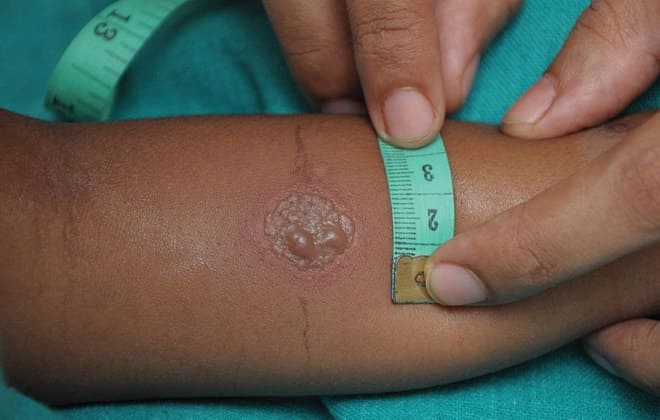
In doubtful cases, Diaskintest and immunological blood tests are used.
Large Mantoux occurs when infected with tuberculosis and reacts to the administration of the BCG vaccine. Allergies, other infections, and vaccinations can affect the results. To find out the cause, you need to be examined by a phthisiatrician.
COMPOSITION OF THE PREPARATION
To perform testing, tuberculin tests are used, consisting of:
- Chemically, thermally treated fragments of bacteria.
- Twin-80 – stabilizer.
- Phenol is a preservative.
- Potassium and sodium phosphates.
- Sodium chloride.
- Water.
As a rule, many parents are frightened by the presence of phenol in the composition of the drug. Yes, it is a toxin, but its presence in the sample is minimal. Therefore, there is no harm to health. Low concentrations of the substance in medical preparations are justified for use.


